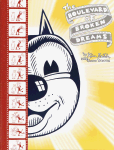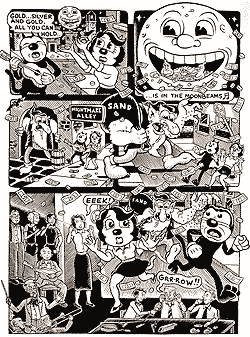
|
Co-written with Deitch's brother, Simon, "Boulevard" focuses on Ted Mishkin, a talented animator whose gifts can never quite overcome his curse. His curse is Waldo, a mischievous cat who walks on his hind legs. Waldo may be a delusion or he may be real, but only Ted can see him. As Mishkin describes him, "he's all charm and cute on the outside, but inside he's pure devil." In a complex play on the concept of the Muse, Waldo inspires Ted to create a like-named cartoon character for the animation studio his brother Al runs. While "Waldo" becomes a national icon, Waldo sends poor Ted to the bottle and in and out of sanatoriums. Paralleling this are the lives of Al, the pragmatic, artless businessman, Lillian, Ted's love interest and Al's mistress, Windsor Newton the pioneering animator, and Nathan, Al's miserable, estranged son and the only other person who sees Waldo. Beginning in the 1910s and ending in the 1990s, "Boulevard" mixes such potboiler elements as murder, sex and betrayal with such themes as the nature of reality, the mystery of inspiration, the exploitation of pop culture and the redemptive power of art.
Take a look at Deitch's art and you will see why he has been so long in earning an audience's favor. Practically every panel in the book has something, often a word balloon, but sometimes an arm or a piece of clothing, poking out over the edge. While not difficult in itself, the technique points to Deitch's fundamental challenge to audiences: the act of transgression. The depiction of Waldo typifies Deitch's disturbing art. Though he looks much like Felix the Cat, with big round eyes and little white gloves, he also sports "cute" male genitalia. Superficially, Deitch's art looks very much like the cartoons of the 1930s — simple and happy with lots of movement and activity in every corner of the frame. But they are done in heavily shaded black and white, rather than bright colors, and depict very adult subjects. Done with such skill, it's an upsetting mix.

|
One of the main themes in "Boulevard," and a main theme in all of Kim Deitch's work, is the blurring of fantasy and reality. One typical scene depicts the recording of sound for a Waldo picture. The comic cuts back and forth between what's happening in the cartoon and what's going on in the studio. The cartoon is itself a parody of what goes on in the animation studio. Finally, the cartoon characters appear to step off of the screen and into the same space as the "real" people. But Deitch goes one further — mixing up true reality with the fantasy of his books. Often he insists that they are true stories. The introduction of "Boulevard" tells of how, as a teenager, Deitch visited the home of an old animator's widow and her reclusive son. Later in the book you are led to conclude they were Al Mishkin's widow and Nathan. Did Deitch really visit such people? Is Waldo meant to be an actual demon from hell or just a hallucination? Deitch never lets on.
After thirty-five years, it's about time Kim Deitch gets his due. The rich ideas and beautiful cartooning of "Boulevard of Broken Dreams," should be just the work to do it. While Deitch likes to explore the seamy, adult world behind the delightful veneer of kiddy pop culture, the book's central theme becomes the transporting power of great Art — even in the form of a cartoon. In the final pages, a tour de force wherein Deitch mixes three different planes of cartoon storytelling, the normally malevolent Waldo has the final say, "Not bad. Not bad at all."
"Boulevard of Broken Dreams" can be found at any bookstore and better comic shops.
